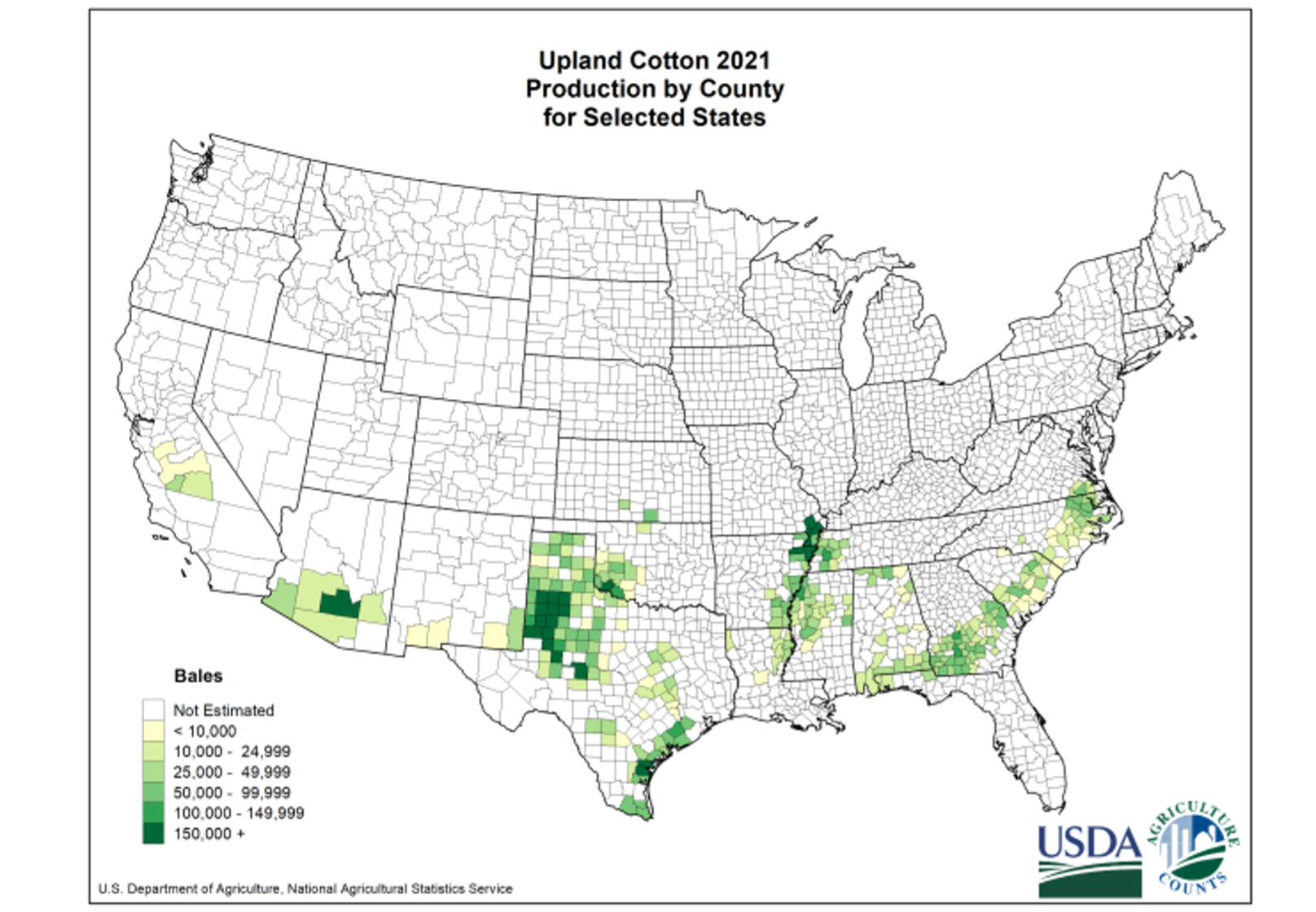The Economic Contribution of the Cotton Industry in Oklahoma
Introduction
In 2021, Oklahoma ranked among the top cotton producers in the United States. The cotton industry’s value in the state exceeded $284 million, making cotton the sixth most valuable commodity overall and the third most valuable crop in Oklahoma.1 Undoubtedly, cotton is an essential component of Oklahoma’s economy.
Background Highlights
- Cotton cultivation in Oklahoma began in 1825 by the Choctaw Nation.
Figure 1. Upland Cotton Production by County in 2021.
- Cotton was grown in 74 out of 77 counties in Oklahoma’s statehood in 1907 with the southern and northeast regions as primary hubs.
- Cotton processing involved more than 300 gins and compressing plants in various cities.
- Today, cotton cultivation is concentrated in the southwestern part of Oklahoma due to improved production efficiency and advancements in seed technologies.
Figure 2. Number of operations with Cotton Harvested in 2017 by County.
Dryland vs. Irrigated Cotton
Dryland cotton production relies on rainfall, making farmers dependent on unpredictable weather patterns. In contrast, irrigated cotton allows farmers to regulate moisture levels and optimize yield. In the past, irrigation required labor-intensive systems, but advancements in the 1970s, like the center-pivot sprinklers, revolutionized the process. This led to a significant increase in cotton yield with Oklahoma harvesting an average of 1,260 pounds per acre in 2009, according to USDA NASS. In 2009, 45% of Oklahoma’s cotton production was irrigated, while 55% was dryland cotton, showing coexistence of both methods in the state’s cotton industry.
Harvest and Transportation
Cotton production in Oklahoma has shifted from manual harvesting to automation with expensive machinery like pickers, strippers and doffers being used. After harvesting, agricultural cooperatives handle key processes like ginning, warehousing, lint merchandizing and cottonseed processing. Altus, Oklahoma, serves as a significant hub for cotton movement in the state with thousands of trucks transporting cotton in and out of the area. To improve efficiency, the Oklahoma Cotton Council proposed the Altus Economic Loop Project, which aims to introduce a railroad loop for quicker and more cost-effective transportation of cotton. The project is still in its early stages.
Economic Contribution
The economic contribution of Oklahoma's cotton sector goes beyond production and processing, considering direct, indirect and induced impacts. Direct impacts involve jobs and value directly created by cotton production, while indirect impacts arise when farmers purchase raw materials for cotton production. Induced impacts occur when farmers and others use their income to buy local goods and services, supporting jobs in the community. Together, these impacts are used to calculate an economic multiplier, indicating additional economic activity generated by the cotton industry.
The cotton sector's influence extends to various industries, including transportation,
real estate, agricultural chemical manufacturing, machinery and equipment rental,
energy, and various local goods and services. The IMPLAN model shows the relationship
between direct impacts and total impacts is significant with a multiplier of 1.82
for employment and 1.65 for industry output, implying that for every 10 jobs directly
created by cotton production, around eight additional jobs are supported, and every
dollar generated by cotton results in an additional $0.65. This demonstrates the cotton
sector's strong contribution to the Oklahoma economy, especially in industries supporting
agriculture and rural areas.
The following table reports IMPLAN results, highlighting employment (measured as jobs) and industry output (measured in dollars).
| Impact | Employment | Industry Output |
|---|---|---|
| Direct | 2,580.1 | $343,343,071 |
| Indirect | 905.1 | $108,211,616 |
| Induced | 685.5 | $114,118,071 |
| Total | 4,170.6 | $565,672,758 |
Table 1. IMPLAN Impact level, Employment, and Industry Output for the Cotton Industry.
Examining the output multiplier in "per bale" terms with cotton prices in the region being between $0.75 and $0.77 per pound, a typical 480-pound bale's price in mid-July 2023 is around $365. With the multiplier of 1.65 for cotton output, each bale contributes an additional $237 to the Oklahoma economy.
Cultural Significance and Non-Monetary Value of the Cotton Industry Highlights
To complement our analysis of the quantitative impact of the cotton sector, we also had the opportunity to assess the non-monetary qualitative value of the sector to Oklahomans in the Southwest region and across the state. From our conversations, we learned the following:
- Cotton farming in southwest Oklahoma holds significant value due to its deep-rooted traditions and cultural connections with many family farms passed down through generations.
- The cotton industry contributes to the state’s economy by providing essential infrastructure and job opportunities for the population.
- Cotton byproducts, like cottonseed, are valuable components in livestock feed, supporting both cotton industry and the broader agricultural sector.
- Cotton production is crucial for creating comfortable and versatile clothing items, making it the preferred choice in the textile industry worldwide.
- Farmers use cotton as a crop rotation option to effectively control weeds in other crops, promoting sustainable agricultural practices and enhancing farmland productivity.
- The cotton industry serves as a source of moral support and valuable life lessons for younger generations with farmers acting as mentors and role models.
Overall, the cotton industry in southwest Oklahoma enriches the fabric of the state’s agricultural heritage beyond its economic contributions.


